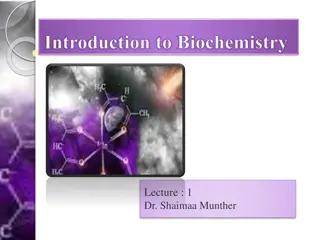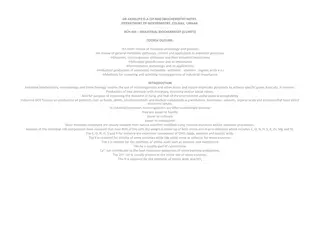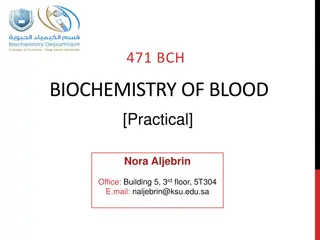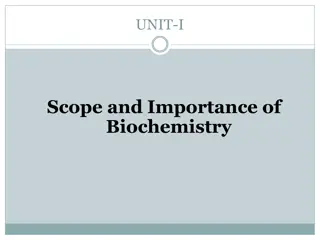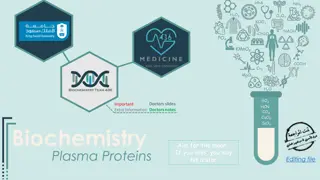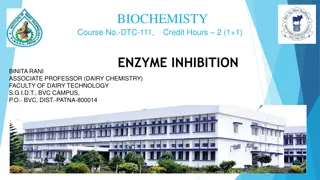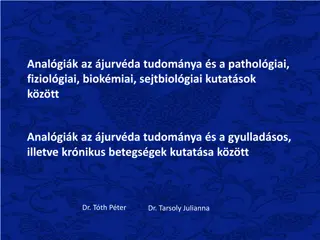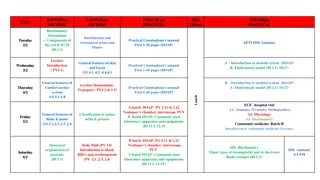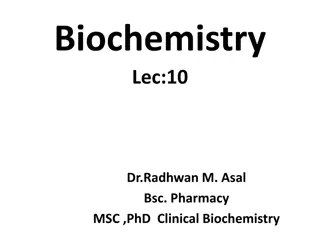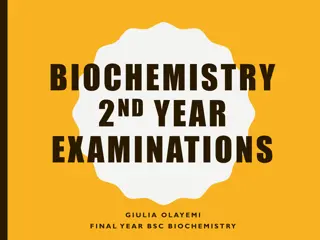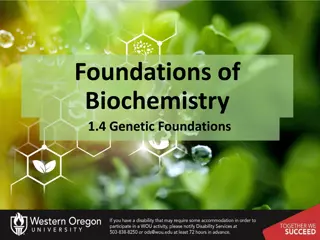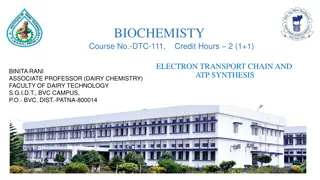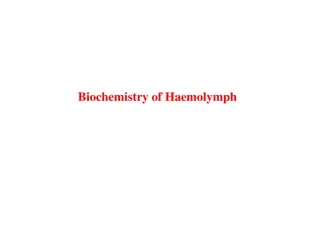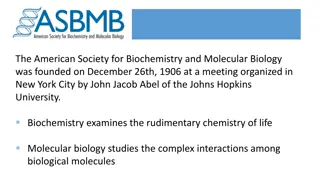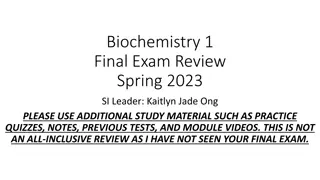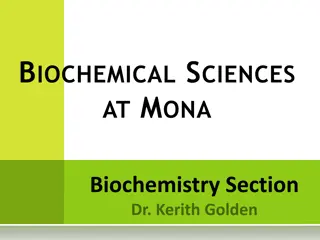General Biochemistry
Biochemistry delves into the molecular structures, functions, and processes common to all living organisms. It reveals the intricate relationship between biomolecules, cellular metabolism, genetic information, and cellular communication. Explore the essential principles of biochemistry, from structure-function relationships to the characteristics of living organisms and the fundamental concepts of cell theory. Understand the significance of bioenergetics, cellular interactions, and the chemical basis of life as you uncover the wonders of this dynamic field.
Download Presentation

Please find below an Image/Link to download the presentation.
The content on the website is provided AS IS for your information and personal use only. It may not be sold, licensed, or shared on other websites without obtaining consent from the author.If you encounter any issues during the download, it is possible that the publisher has removed the file from their server.
You are allowed to download the files provided on this website for personal or commercial use, subject to the condition that they are used lawfully. All files are the property of their respective owners.
The content on the website is provided AS IS for your information and personal use only. It may not be sold, licensed, or shared on other websites without obtaining consent from the author.
E N D
Presentation Transcript
General Biochemistry Dr. Saad hussein khudhair
What is Biochemistry? Biochemistry is the chemistry of the living cell. It describes in molecular terms the structures, mechanisms, function and chemical processes shared by all livingorganisms. It provides fundamental understanding of the molecular basis for the function of livingthings. It provides a broad understanding of the molecular basis oflife. Examples: The chemical structures ofbiomolecules. Interactions leading to formation of supermacro-molecules , cells,multi- cellular tissues, andorganisms. Bioenergetics of the reactions in thecell. Storage and transmission ofinformation. Chemical changes during reproduction, aging, and death ofcells. Regulation of chemical reactions inside livingcells.
Principal Areas of Biochemistry Structure-function relationship: Structural Chemistry for proteins, carbohydrates, DNA/RNA, lipids, and every other component in the cell. Functions of these components Relationship between structure and function. Metabolism: Catabolism: Pathways of chemical reactions leading to the breakdown of molecules Anabolism: pathways of chemical reactions leading to synthesis of molecules. Bioenergetics of reaction as well as management of cellularEnergy. Cellularcommunication Storage, transmission, and expression of genetic information DNA replication and protein synthesis. Cell-cell communication & interaction Signal transduction
Cell Theory The main parts of the cell theory today are: Cell is the smallest unit of living matter. Don t confuse this with electrons, protons, atoms, proteins, DNA,etc. These are lifeless molecules Cell is the structural & functional unit of all organs and/or organisms. All organisms are composed of one or more types of cells. All cells come from pre-existing cells by division. Cells contains hereditary information which is passed from cell to cell during cell division. All energy flow (metabolism & biochemistry) of life occurs within cells.
Typical Cells Cells from different organisms have different shapes, structures, and sizes. All cells have protoplasm. They are usually divided into two broad groups: Eukaryotesand Prokaryotes. Eukaryotic cells (Eu = true; kary = nucleus): have a membrane-bound nucleus and a variety of organelles and internal membranes. Prokaryotic cells (Pro = before) are smaller (a general rule) and lack much of the internal compartmentalization and complexity of eukaryotic cells; No membrane-bound nucleus or other organelles.
Characteristics of Living Organisms There are 6 main Characteristics: 1- The highly organizedCells 2- Relation with energy 3- Grow and Reproduce with high fidelity 4- Interact with environment 5 Movement 6 Homeostasis
Chemical elements of cell Chemical elements of a living cell are the same as in the Earth scrust, but in diferent proportions.
Chemical Elements of Life C H N O P S: are the most abundant elements in cell. They account for more than 99% of atoms in the human body H, O, N and C have common properties that are important to the chemistry of life. They all: have relatively low atomicnumbers capable of forming one, two, three and four bonds (for H, O, N and C ,in order). form the strongest covalent bonds ingeneral. Write the atomic number and the atomic mass of each element (CHNOPS)
Chemistry and Life Living organisms operate within the same laws that apply to physics and chemistry: Conservation of mass, energy Laws of thermodynamics Laws of chemical kinetics Principles of chemical reactions
Chemistry of biomolecules There are 5 major forces that maintainthe structure of biomolecules: Only one is a strong force: Thecovalent bond The others are considered weak forces: The ionic bond The hydrogen bond Hydrophobic interaction (not chemical bond) Van Der Waals attraction (not chemical bond) 1. 2. 3. 4.
The 4 Major macromolecules There are 4 major macromolecules (polymers) in the cell formed by condensation of smaller building blocks (monomers) by the removal of H2O (dehydration): Macromolecule (polymers) Carbohydrate Proteins Nucleic acids Lipids Buildingblocks (monomers) Monosaccharides Amino acids Nucleotides Fatty acids + alcohol Name of bond Glycosidic bond Peptide bond Phospho diesterbond Ester bond
Characteristics of biological molecules All macromolecules have a Sense or Directionality DNA: -ATC- -CTA- Protein: -Gly-ser- -Ser-Gly- Carbohydrate: -Glu-Gal -Gal-Glu- Macromolecules are Informational: Examples: Examples: AUC= Isoleucine; UAC= Tyrosine ACU= Threonine; Macromolecules Have Characteristic Three- Architecture Dimensional Weak forces maintain biological structure and biomolecular interactions determine
Functional Groups in Biochemistry Examples from biochemistry R OH Alcohol OH Example: amino acid (serine) Hydroxyl SH R SH Thiol Example: amino acid (cysteine) Sulfahydryl O C O O Example: fatty acid (Palmitic acid) RC O- OH RC OH Carboxylicacid CH3(CH2)16COOH Carboxylate
Functional Groups in Biochemistry Examples from biochemistry O C O C R Acyl O C R R Example: acetone Carbonyl Ketone O P O- O- O O P O- OH Phosphate Example: Phosphatetic acid Phosphoryl O C H O Example: acetamide R R C NH2 Amide Aldehyde
Functional Groups in Biochemistry (Cont.) Examples from biochemistry R1 N R2 Tertiary R1 N H + NH3 R NH2 Primary R R NH2 Secondary Amino Amines Example: Urea


